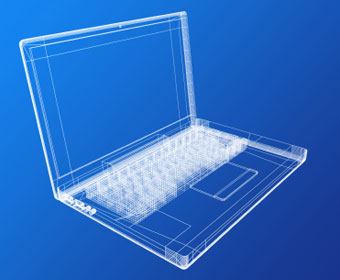It seems that every vendor is getting on the netbook bandwagon-and if they're not, they're trying to get their own bandwagon rolling with a raft of similar form factor devices. Consumers love netbooks as a cheap, internet-enabled PC substitute and carriers seem happy to subsidise them in order to drive mobile broadband subscriptions.
August 20, 2009

It seems that every vendor is getting on the netbook bandwagon-and if they’re not, they’re trying to get their own bandwagon rolling with a raft of similar form factor devices. Consumers love netbooks as a cheap, internet-enabled PC substitute and carriers seem happy to subsidise them in order to drive mobile broadband subscriptions.
US chip vendor Qualcomm got the ball rolling in late May with the creation of a ‘new’ form factor that falls somewhere between the high-end smartphone and the netbook. The “smartbook” as Luis Pineda, senior vice president of marketing and product development at Qualcomm, dubbed the device, promises, “the smartphone experience in a larger form factor.”
This all sounds a bit too much like Palm’s ill-fated Foleo strategy. There is already a wide range of netbooks available for under the $500 mark, many of which boast a full fledged operating system like Linux or Windows XP, integrated wifi and 3G, and a highly portable form factor. Nevertheless, Pineda said that around 15 companies are on board with the concept and there are around 30 such devices in development. The first of these will hit the shelves towards the end of 2009.
Qualcomm would not name names, but Acer, Compal, Inventec, Samsung, Asus, Foxconn, LG, Toshiba, C-motech, HTC, Quanta and Wistron are all known users of the Qualcomm Snapdragon platform, which forms the foundation of the smartbook platform. Snapdragon, as a single chip solution combining GPS, multimedia, the processor, wifi and 3G on one chip, promises to make smartbooks lighter, thinner, cheaper and give them a longer battery life.
“Snapdragon is a key chipset for computing products,” said Pineda, “and we’re now looking at new devices beyond the cellphone, with a larger display, full keyboard, and an enhanced user experience.”
But rivals Intel and Nokia were not to be outdone, teaming up just a few weeks later to, “define a new mobile platform beyond today’s smartphones, notebooks and netbooks”. As part of a long term partnership, the two firms will seek to develop another new class of mobile computing device and chipset architecture which will combine performance with mobile broadband connectivity in a user-friendly ‘pocketable’ form factor, the firms said.
Linux will be the glue that holds the joint effort together
Both companies have their own in-house Linux projects-Intel with Moblin and Nokia with Maemo-and will align their respective strategies around a number of key open source technologies such as oFono, ConnMan, Mozilla, X.Org, BlueZ, D-BUS, Tracker, GStreamer, and PulseAudio. Incidentally, Intel recently acquired mobile and embedded devices software firm Wind River for $884m and said it would licence Nokia’s HSPA 3G modem technologies to complement its own mobility platforms.
But competition is going to be fierce in the netbook arena. In July, finally confirming months of speculation, PC manufacturer Dell made official its plans to make a play for the mobile space, with a focus on netbook sized devices. At a Dell analyst event, Ron Garriques, head of the company’s consumer division, said that the telco channel is the next market the company will address.
“Operators want us to create a set of products that work together with a common user interface as well as operator services,” said Garriques, who joined Dell from Motorola’s handset unit. “Operators don’t care how we execute that strategy, they just want us to be the integrator, providing an end to end solution that supports LTE or WiMAX. We’re really onto the 3G to 4G transition now, and consumers are looking for up to 16″ displays on portable devices Carriers want end to end solutions, bundled with software that makes everything work,” he said.
Garriques said Dell is targeting the top three or four operators worldwide to see what their needs are, because there are “massive needs that are not being met at present.” The company might also look to Chinese or Taiwanese manufacturers to build the device and just put its own branding on them, he said.
In mid-August a Dell designed smartphone made an appearance at a Chinese tradeshow. The Dell Mini 3i is understood to be a GSM handset possibly designed for China Mobile.
Naturally, Garriques’ mention of a standard user interface got tongues wagging about Android, and Google wasn’t far from the limelight with its own announcement of a full fledged internet-focused operating system to complement Android, dubbed Chrome.
Google kick-started the Android project in November 2007, carving itself a niche in the mobile and portable devices space as well as set top boxes and other consumer electronics. Then in September 2008, the web giant launched the Chrome browser, which neatly integrates with Google’s online services and is targeted at online users. The web giant said that Acer, Adobe, ASUS, Freescale, Hewlett-Packard, Lenovo, Qualcomm, Texas Instruments, and Toshiba had all signed up to get involved in the Chrome OS either on a hardware or software level.
As with Android, Google is tapping the open source community to drive Chrome forward. Later this year the firm will open source the code base, and netbooks running Google Chrome OS will be available for consumers in the second half of 2010.
Read more about:
DiscussionAbout the Author(s)
You May Also Like








.png?width=300&auto=webp&quality=80&disable=upscale)


_1.jpg?width=300&auto=webp&quality=80&disable=upscale)


.png?width=800&auto=webp&quality=80&disable=upscale)